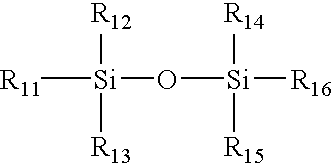Contact lens materials
a technology of contact lens and hydrogel, which is applied in the field of contact lens materials, can solve the problems of poor comfort, phase separation, and damage to the epithelial layer, and achieve the effect of reducing cross-linking density and high oxygen permeability
- Summary
- Abstract
- Description
- Claims
- Application Information
AI Technical Summary
Benefits of technology
Problems solved by technology
Method used
Image
Examples
example 1
Preparation of 1,3-bis(4-methacryloyloxybutyl)tetramethyl Disiloxane (M2)
[0060]To a 5 liter four neck resin flask equipped with a mechanical stirrer, Dean-Stark trap, heating mantle, water cooled condenser and thermometer was added 1,1 dimethyl-1-sila-2-oxacyclohexane (521 g, 4.0 mol), methacrylic acid (361 g, 4.2 mol), and concentrated sulfuric acid (25.5 g). To the reaction mixture was then added IL of cyclohexane and hydroquinone (0.95 g, 8.6 mmol) as a polymerization inhibitor. The reaction mixture was heated to reflux for five hours during which time 28 mL of water was collected. The reaction mixture was then cooled, divided and passed through two chromatography columns filled with 1 kg of alumina (packed using cyclohexane as eluent). The cyclohexane was removed using a rotary evaporator and the resultant M2 was placed under vacuum (0.2 mm Hg) for one hour at 80° C. (yield, 80%; purity by gas chromatography, 96%).
example 2
Synthesis of Methacrylate End-Capped Poly Dimethylsiloxane (M2D25)
[0061]To a 1,000-mL round-bottom flask under dry nitrogen was added octamethylcyclotetrasiloxane (D4) (371.0 g, 1.25 mol) and M2 (27.7 g, 0.7 mol). Triflic acid (0.25%, 1.25 g, 8.3 mmol) was added as initiator. The reaction mixture was stirred for 24 hours with vigorous stirring at room temperature. Sodium bicarbonate (10 g, 0.119 mol) was then added and the reaction mixture was again stirred for 24 hours. The resultant solution was filtered though a 0.3-μ-pore-size Teflon® filter. The filtered solution was vacuum stripped and placed under vacuum (>0.1 mm Hg) at 50° C. to remove the unreacted silicone cyclics. The resulting silicone hydride-functionalized siloxane was a viscous, clear fluid: yield, 70%.
examples 17-30
Films Prepared with M2D25 Endcapped with 10% Mole Trimethylsilyl
[0065]This prepolymer was prepared by same procedure as above except that for the following amounts: M2 9.08 grams, D4 40.57 grams, T2 (hexamethyldisiloxane) 0.35 grams and triflic acid 0.125 grams.
[0066]
TABLE 2Films prepared using M2D25 endcapped with 10% mole trimethylsilylDMATRISM2D25DKH2OWeightModulusH2OExample(parts)(parts)(parts)(Barrers)(%)Loss (%)(g / mm2)trans1720.0039.5020.00200.0011.6917.421631.161823.9533.1022.45160.4018.0419.471919.531935.0024.5020.0080.4032.6219.4817991.352035.0020.0024.5077.8033.8924.612632.682120.0029.5030.00187.3010.6517.722462.792220.0039.5020.00208.009.9718.701646.042320.0034.5025.00198.6011.9319.152157.722435.0020.0024.5084.5031.8019.2725090.992529.5020.0030.00120.2023.3319.1932940.442624.7524.7530.00164.1017.4319.5527520.542735.0024.5020.0075.8034.0621.0319079.862820.0029.5030.00158.3011.8820.162842.912931.4523.3524.70102.7027.0322.1427259.793027.9026.7024.90119.7022.9721.1123222.55
Fi...
PUM
| Property | Measurement | Unit |
|---|---|---|
| weight percent | aaaaa | aaaaa |
| time | aaaaa | aaaaa |
| hydrophilic | aaaaa | aaaaa |
Abstract
Description
Claims
Application Information
 Login to View More
Login to View More - R&D
- Intellectual Property
- Life Sciences
- Materials
- Tech Scout
- Unparalleled Data Quality
- Higher Quality Content
- 60% Fewer Hallucinations
Browse by: Latest US Patents, China's latest patents, Technical Efficacy Thesaurus, Application Domain, Technology Topic, Popular Technical Reports.
© 2025 PatSnap. All rights reserved.Legal|Privacy policy|Modern Slavery Act Transparency Statement|Sitemap|About US| Contact US: help@patsnap.com



